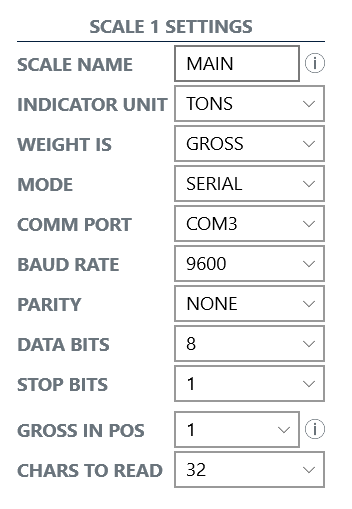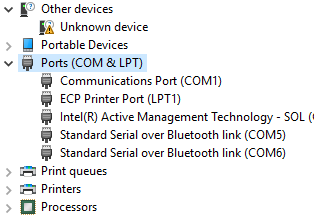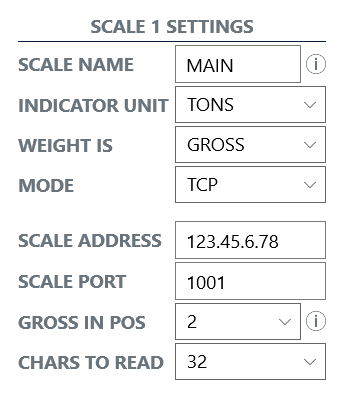Connecting a Scale to the App
Fast-Weigh Desktop Ticketing Application
Setting up a Scale
In the FW Desktop ticketing app, the weight reads 0. How do I configure the scale so the program can read it? What you're actually configuring are the settings for the weight indicator attached to the scale, not the scale itself.
How do I configure my Weight Indicator?
- The weight indicator will need to output a continuous data string in order for the Desktop App to read the Weight.
- Once this is set, our system can read data from your weight indicator using two methods:
- Via RS-232 serial output from the weight indicator, which is then converted to USB using a prolific Serial to USB converter. Windows 10 and newer cannot read serial or USB data directly.
- We recommend the Insignia Brand Serial to USB adapter from Best Buy.
- Note: The Keyspan brand Serial to USB adapter cannot be used to send weights to the Fast-Weigh desktop application.
- By broadcasting data from the weight indicator over TCP
- You can configure your Weight Indicator over IP by utilizing a Web Switch
Configuring Your Scale in the Desktop App
 To configure the weight indicator, go to SETTINGS. Settings will also open the first time you run the program after installation.
To configure the weight indicator, go to SETTINGS. Settings will also open the first time you run the program after installation.
Navigate to DEVICES to enter your scale settings.
Configuring the Weight for Serial to USB Connection

- The specs needed to read the weight indicator are the COMM Port, Baud Rate, Parity, Data Bits, Stop Bits, Gross in POS and Chars to Read.
- The COMM Port refers to which port your serial-to-USB adapter is using in your PC.
- You can find this by visiting the Device Manager in Windows and viewing Ports (COM & LPT)

- The Baud Rate, Parity, Data Bits, and Stop Bits scale specs can often be found within the settings in the ticketing software used before switching to FW, on the back of the weight indicator, or in the weight indicator instruction manual.
- After configuring these settings, Test the Connection to the Weight Indicator using the ( i ) icon next to the Scale Name. You should see a number, but it may not be the current weight from the scale yet.
- Note: If you are not getting a number, you will need to revisit the above steps to make sure they are correct before moving on.
- If you are getting a connection but the number isn't the weight, you will need to use the second ( i ) icon next to Gross in POS to read the settings needed for the Gross in POS and the Chars to Read.
- Note: This can sometimes take a while to read, let this run until your get a result!
- Input the Gross in POS and Chars to Read settings that are displayed in the pop-up.
Configuring the Weight for TCP Connection
 Configure the Scale IP connection through your web browser by inputting the IP into the browser.
Configure the Scale IP connection through your web browser by inputting the IP into the browser. - The IP settings are generally password protected, but you can find the default login in the Web Switch user manual.
- Configure the Baud Rate, Parity, Data Bits, and Stop Bits through the IP connection settings.
- Locate the Port Number for the scale.
- Note: This setup will vary depending on the Web Switch used.
- In the Desktop App, set the Mode to TCP.
- Next, input the IP address for the Weigh Indicator into Scale Address and the IP Port number into Scale Port.
- Test the Connection to the Weight Indicator using the ( i ) icon next to the Scale Name. You should see a number, but it may not be the current weight from the scale yet.
- Note: If you are not getting a number, you will need to revisit the above steps to make sure they are correct before moving on.
- If you are getting a connection but the number isn't the weight, you will need to use the second ( i ) icon next to Gross in POS to read the settings needed for the Gross in POS and the Chars to Read.
- Note: This can sometimes take a while to read, let this run until your get a result!
- Input the Gross in POS and Chars to Read settings that are displayed in the pop-up.
If you cannot locate your weight indicator specs or Fast Weigh is not reading the weight, please contact us at support@tacinsight.com or call 865-219-2980 during business hours.
Related Articles
Scale House Setup Checklist
Fast-Weigh Desktop Ticketing Application To find out if you are ready to run Fast-Weigh Desktop at your scale house, please go through this hardware checklist: My scale house PC has at least 4GB of RAM and 64GB of hard drive space My weight indicator ...Ticket History on the Scale App
Fast-Weigh Desktop Ticketing Application Even though all of your ticket data syncs to the Web Portal, your Scale Application stores some of that information locally for easy access. History To view your local Ticket History, navigate to the History ...Creating & Managing Orders on the Scale App
Fast-Weigh Desktop Ticketing Application You can create and manage Orders directly from the Scale App, if you have the Order Add/Update setting turned on. All of the Orders created for your location can be viewed and updated, or you can quickly add a ...Desktop Scale App Settings: Customizing your Ticketing App
Fast-Weigh Desktop Ticketing Application The settings for the Desktop Ticketing App can shape the way that your operations function. please contact us at support@tacinsight.com or call 865-219-2980 during business hours if you need assistance with ...Save Your Settings with the Scale Configuration and Device Info Backup Tool
Fast-Weigh Desktop Ticketing Application You can now back up your settings and scale configurations and store them in the cloud. Once config has been saved, if your current Fast-Weigh desktop ticketing application is lost or wiped, the settings can ...